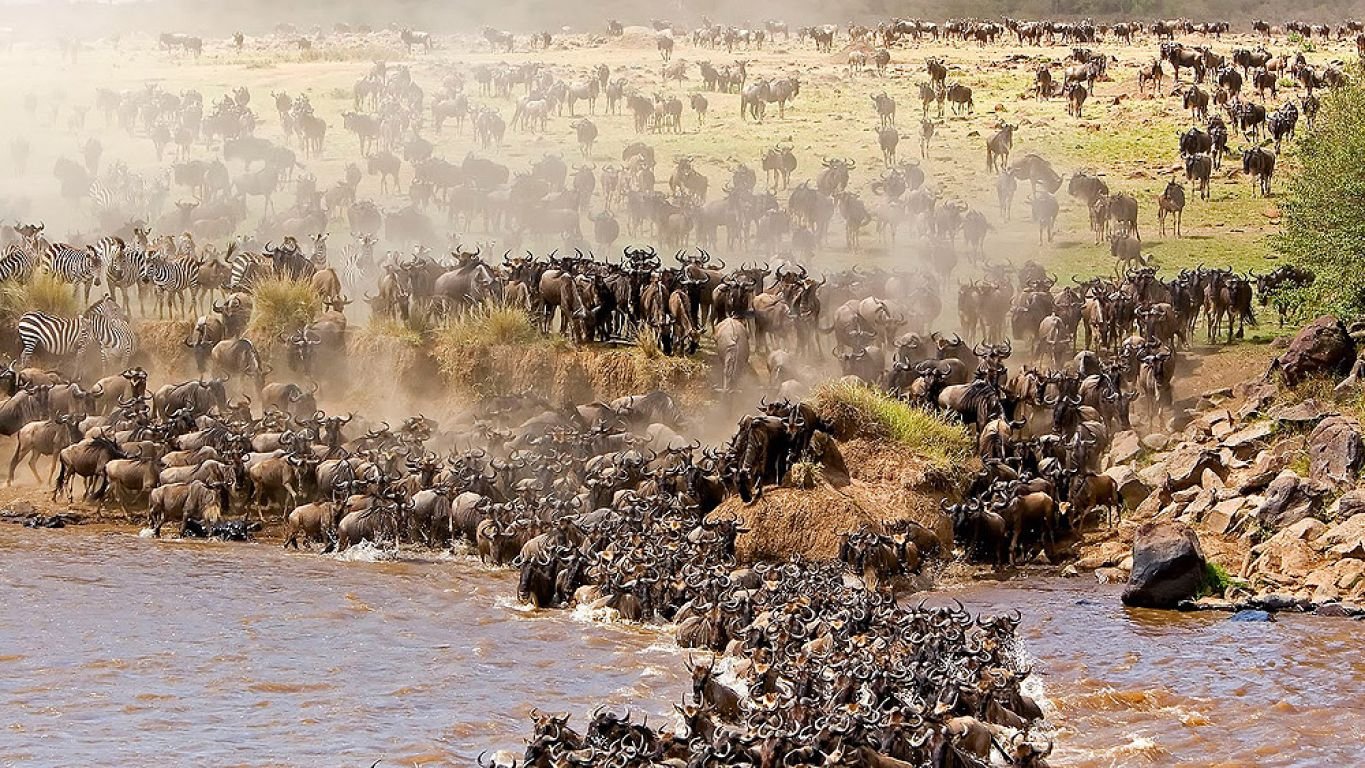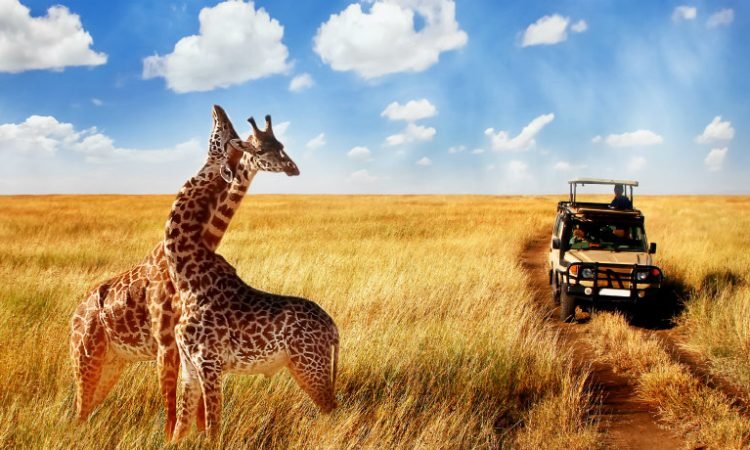The Serengeti is a world-renowned wildlife destination located in northern Tanzania. This sprawling park is home to some of the planet’s most extraordinary creatures, offering visitors a chance to experience nature in its purest form.
From January to March, the southern Serengeti becomes a calving ground, where thousands of wildebeest give birth. This is an exciting time for visitors, as predators like lions, cheetahs, and hyenas gather for easy prey. The migration is an ongoing cycle, with different phases occurring throughout the year.
The Serengeti is teeming with other wildlife, including cheetahs, giraffes, zebras, gazelles, hippos, and hundreds of bird species. The vast, unobstructed plains make it easy to spot wildlife from a distance, offering picture-perfect views.
The Serengeti is a year-round destination, but the best time to visit depends on what you want to experience. The dry season is ideal for game viewing, as animals gather around water sources. The Great Migration river crossings offer incredible safari experiences.
The Serengeti is one of the world’s most spectacular wildlife paradises. From luxury lodges to eco-conscious camps, a visit to the Serengets will leave you with memories that last a lifetime.
 15
Oct
15
Oct
The Serengeti is a world-renowned wildlife destination located in northern Tanzania, celebrated for its vast grasslands, savannahs, and incredible wildlife spectacles. This sprawling park is home to some of the planet’s most extraordinary creatures, offering visitors a chance to experience nature in its purest form. From the famous Great Migration to the iconic Big Five, the Serengeti truly is a wildlife paradise, drawing nature lovers, photographers, and adventurers from all over the globe.
In this guide, we’ll explore why the Serengeti is a must-visit safari destination. Whether you’re planning your first visit or just dreaming of one, this article will give you valuable insights into the Serengeti’s diverse wildlife, when to go, what to expect, and key highlights that make this destination so unique.
A Snapshot of the Serengeti
The Serengeti National Park, a UNESCO World Heritage Site, spans around 14,750 square kilometers (5,700 square miles) and is part of the larger Serengeti ecosystem, which extends into Kenya’s Masai Mara. The word “Serengeti” means “endless plains” in the Maasai language—a fitting description for this vast, open landscape.
Established in 1951, the Serengeti is one of Africa’s most important conservation areas, preserving its rich wildlife and unique ecosystems. It’s home to diverse animal species, from big predators to graceful herbivores, and offers a rare glimpse into the delicate balance of nature.
 The Serengeti
The Serengeti
The Great Migration: Nature’s Greatest Spectacle
One of the most famous natural events on Earth is the Great Migration, where over 1.5 million wildebeests, 200,000 zebras, and countless gazelles embark on a year-long journey across the Serengeti and Masai Mara in search of fresh grazing lands.
Migration Routes and Timing
The migration is an ongoing cycle, with different phases occurring throughout the year. From January to March, the southern Serengeti becomes a calving ground, where thousands of wildebeest give birth. This is an exciting time for visitors, as predators like lions, cheetahs, and hyenas gather for easy prey.
In April, the herds start moving north, passing through central and western Serengeti. By June and July, they reach the Grumeti River, where one of the most dramatic moments of the migration occurs—thousands of wildebeests and zebras brave the crocodile-filled river, making for a nail-biting spectacle.
In August and September, the herds cross into Kenya’s Masai Mara via the Mara River. This river crossing is equally thrilling, as the animals face strong currents and lurking predators. After grazing in the Mara, the herds eventually return south, completing the migration cycle.
How to See the Migration
If witnessing the Great Migration is on your list, it’s crucial to plan according to the movement of the herds. Safari lodges are positioned at key points along the migration routes, allowing visitors to see this incredible event at various times of the year.
The Big Five and More Wildlife
The Serengeti is home to Africa’s Big Five: lions, leopards, elephants, buffaloes, and rhinos, along with many other fascinating species.
Lions: Kings of the Serengeti
With around 3,000 lions, the Serengeti has one of the largest lion populations in the world. They are commonly seen lounging in the sun, hunting in the plains, or resting on rock formations known as kopjes.
Leopards: The Elusive Predators
Leopards are solitary and stealthy, often spotted resting in trees or hidden in thick brush. The Serengeti’s varied landscape provides excellent cover for these elusive big cats.
Elephants: Majestic Giants
African elephants, the largest land mammals, roam the Serengeti in large herds. These gentle giants are often seen grazing or cooling off in waterholes, adding to the park’s diverse wildlife experiences.
Buffaloes: Fearsome Grazers
Cape buffaloes, known for their unpredictable nature, can be found in large herds throughout the park. While they may appear calm, they are considered one of the most dangerous animals in Africa.
Rhinos: Rare and Endangered
The critically endangered black rhino is a rare but special sight in the Serengeti. Conservation efforts have helped protect these majestic animals, but sightings are still a highlight due to their rarity.
More Wildlife to Discover
In addition to the Big Five, the Serengeti is teeming with other wildlife, including cheetahs, giraffes, zebras, gazelles, hippos, and hundreds of bird species. Each safari brings something new and unexpected.
The Serengeti’s Landscapes
The Serengeti is more than just wildlife—it’s a stunning display of natural beauty, with varied landscapes that range from open plains to dense woodlands.
Endless Plains
The central and southern Serengeti is dominated by open grasslands, where large herds of herbivores graze and predators lurk. The vast, unobstructed plains make it easy to spot wildlife from a distance, offering picture-perfect views.
 The Serengeti
The Serengeti
Rocky Kopjes
Scattered across the plains are rocky outcrops called kopjes, which serve as prime lookout points for predators like lions and leopards. These ancient formations also house smaller species, creating mini ecosystems.
Woodlands and Riverine Forests
In the northern and western Serengeti, woodlands and riverine forests provide more cover for wildlife. These areas are particularly favored by elephants, giraffes, and leopards, as well as a variety of bird species.
Grumeti and Mara Rivers
The Grumeti and Mara Rivers play a crucial role in the Serengeti’s ecosystem. These rivers are also the site of dramatic river crossings during the Great Migration, where herds must navigate treacherous waters teeming with crocodiles.
When to Visit the Serengeti
The Serengeti is a year-round destination, but the best time to visit depends on what you want to experience.
Dry Season (June to October)
The dry season is ideal for game viewing, as animals gather around water sources, and the sparse vegetation makes spotting them easier. It’s also the time when the Great Migration river crossings take place, offering incredible safari experiences.
Wet Season (November to May)
During the wet season, the Serengeti turns lush and green, and while wildlife may be more spread out, it’s the best time for birdwatching and seeing newborn animals. The calving season (January to March) is particularly exciting, with thousands of baby wildebeests and zebras filling the plains.
Safari Activities in the Serengeti
A Serengeti safari offers a variety of ways to explore the park, from game drives to hot air balloon rides.
Game Drives
The most popular way to explore the Serengeti is through guided game drives. Early morning and late afternoon drives offer the best chance to see wildlife, and your guide will share insights into the animals and ecosystems along the way.
Hot Air Balloon Safaris
For a unique and breathtaking view of the Serengeti, consider a hot air balloon safari. Soaring high above the plains at sunrise, you’ll witness the vast landscape and wildlife from a whole new perspective.
Walking Safaris
If you’re after a more intimate experience with nature, walking safaris allow you to explore the Serengeti on foot, accompanied by a knowledgeable guide. You’ll learn about the smaller details of the ecosystem while staying alert to wildlife encounters.
Cultural Tours
Cultural tours give visitors a chance to meet the local Maasai people and learn about their traditions and way of life. These tours provide valuable insight into the history and culture of the region, enriching your Serengeti experience.
Conservation in the Serengeti
While the Serengeti remains a wildlife haven, it faces conservation challenges, including poaching, habitat loss, and human-wildlife conflict. However, ongoing efforts by local communities, governments, and conservation organizations are working to protect this incredible ecosystem. Sustainable tourism plays a critical role in these efforts, with many lodges and camps adopting eco-friendly practices to minimize their environmental impact.
 The Serengeti
The Serengeti
Conclusion
The Serengeti is not just a destination; it’s a life-changing experience. Whether you’re drawn by the thrill of the Great Migration, the majesty of the Big Five, or the breathtaking landscapes, the Serengeti offers an unforgettable adventure. From luxury lodges to eco-conscious camps, a visit to the Serengeti will leave you with memories that last a lifetime.
Plan your next safari with Providence Safari and discover why the Serengeti is truly one of the world’s most spectacular wildlife paradises.
